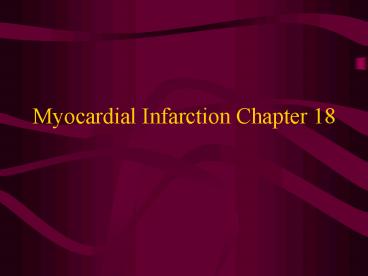Myocardial Infarction Chapter 18 PowerPoint PPT Presentation
1 / 17
Title: Myocardial Infarction Chapter 18
1
Myocardial Infarction Chapter 18
2
Acute Myocardial Infarction (AMI)
- AKA ST segment elevation myocardial infarction
(STEMI) - Occlusion of coronary artery causes myocardium to
be ischemic and tissue death occurs
3
AMI continued
- Until the 80s, AMI was treated symptomatically
- pain control, arrhythmias resolved, bed rest,
nitrates, B-blockers to minimize oxygen
requirement of heart
4
AMI continued
- Angiographic studies showed that 87 had occluded
coronary arteries that led to development of
thrombolytics and PTCA (percutaneous transluminal
coronary angioplasty ) which are now first line
therapies.
5
AMI continued
- 1/2 million have AMI every year
- 30 dead before hospital (v.fib)
- if make it to hospital, 1 year death rate is
greater than or equal to 15 - usually located in specific region (anterior,
lateral, inferior,posterior) see Fig. 18-3.
(anterior worse than inferior or lateral)
6
AMI Continued
- Can develop permanent ECG changes after MI (Q
waves) - Q wave MI-STEMI
- Now Q wave MI - Non-ST segment elevation (NSTEMI)
or acute coronary syndrome (ACS)
7
Clinical Presentation
- Substernal chest pain or pressure, short of
breath, diaphoresis, nausea and vomiting. - Can look like indigestion or other diseases may
present like STEMI (table 18-1) - 20 of AMI are silent - elderly and diabetics,
may present with hypotension or cerebrovascular
symptoms rather than chest pain.
8
Clinical Presentation continued
- Physical exam - may have increased or decreased
BP, tachycardia (gt120 BPM) suggest large area of
damage. Fourth heart sound (S 4 ) may be heard
9
Diagnosis
- In addition to HP, ECG and enzymes help to
diagnose - usually 2 of the 3 are needed to assign diagnosis
of MI - ECG- St segment elevation, 12-lead helps to
determine location of infarct - New Q wave, new bundle branch block, ST elevation
are all consistent with/MI
10
Diagnosis Continued
- IF have chest pain without ST elevation or enzyme
changes, then called Unstable Angina. - IF have chest pain without ST elevation but have
enzyme changes then called AMI, NSTEMI - These pts have some limited blood flow with
partial occlusion due to platelets and
fibrinogen-Thrombolytics dont help these pts.
11
Cardiac Enzymes
- Released when cardiac cell is injured
- CK-MB - most specific of creatinine kinase (CK)
enzymes for cardiac tissue - appears 3-6 hrs. after damage, PK 12-24 hrs
- false elevations Table 18-2
- LDH - lactate dehydrogenase -24-48 hours after MI
pk in 3-6 days - false elevations-liver disease, hemolysis,
leukemia, PE, etc. - Troponin - most sensitive, has replaced LDH
12
Compilcations
- Pump failure, arrhythmias, recurrent ischemia and
reinfarction - H.F. common if MI affects 20-25 of left
ventricle - cardiogenic shock and death - gt40 of left
ventricle
13
Complications continued
- Ventricular remodeling- results from decreased
contractility and compensatory increase in left
ventricle volume and pressure. - Arrhythmias - post infarction, heart is irritable
and subject to ventricular arrhythmias.
14
Drug Therapy (table 18-5)
- Thrombolytics- opens occluded artery, Timi grade
3- (complete repurfusion), the earlier the
better. Reduced mortality by 1/3, - binds to plasminogen -gt plasmin -gt fibrinolytic
(acts on fibrin clot) - Table 18-3
- problems- doesnt open 100 of occlusions, may
not remain open, bleeding (need to select
properly) - Table 18-4
15
Drug Therapy continued
- When fibrin clot disintegrates, paradoxical
increase in local thrombin generation and
increase platelet aggregability. - So need heparin, LMWH and ASA / GPIIBIIIA
- B-blockers decrease morbidity and mortality
- decrease myocardial oxygen requirements
- limits damage and decreases complications
- should be used in AMI unless CI
16
Drug Therapy continued
- Vasodilators - decrease myocardial oxygen demand
by decreasing afterload and decreasing preload
and can limit remodeling. - Also increase myocardium blood supply by coronary
vasodilation
17
Acute Myocardial Infarction (AMI)
- AKA ST segment elevation myocardial infarction
(STEMI)

